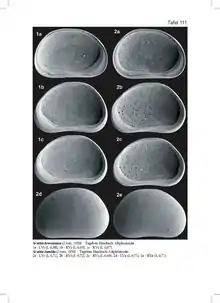Taxonavigation

Scottia browniana (Jones, 1850) (Scanning electron micrographs)
| Taxonavigation: Cypridoidea |
|---|
|
Superregnum: Eukaryota |
Familia: Cyprididae
Subfamilia: Scottiinae
Tribus: Scottiini
Genus: Scottia
Species: †Scottia browniana
Name
Scottia browniana (Jones, 1850) Brady & Norman 1889
- Original binomen: Cypris browniana Jones, 1850
- UTIN (Universal Taxonomic Identification Number) Ostracoda: G0524 01151
- Type locality: Clacton-on-Sea (Essex, England)
- Type horizon: Hoxnian interglacial.
- Synonyms
- Cyclocypris triebeli Kempf, 1967
- Authority for synonymy: Kempf, 1971: 50
- Distribution: Middle Pleistocene Europe.
Primary references
- Jones, T. R. 1850: Description of the Entomostraca of the Pleistocene Beds of Newbury, Copford, Clacton, and Grays. Annals and Magazine of Natural History, series 2 (London): 6 (1): 25–28.
- Brady, G. S. & Norman, A. M. 1889: A monograph of the marine and freshwater Ostracoda of the North Atlantic and of north-western Europe. Section I: Podocopa. The Scientific Transactions of the Royal Dublin Society (Series 2), 4 (2): 63–270.
- Kempf, E. K. 1967: Ostrakoden aus dem Holstein-Interglazial von Tönisberg (Niederrheingebiet). Monatsberichte der Deutschen Akademie der Wissenschaften zu Berlin. Mitteilungen aus Mathematik, Naturwissenschaft, Medizin und Technik, 9: 119–139.
- Kempf, E. K. 1971: Ökologie, Taxonomie und Verbreitung der nichtmarinen Ostrakoden-Gattung Scottia im Quartär von Europa. Eiszeitalter und Gegenwart, 22: 43–63. PDF
Additional references
- Diebel, K. & Pietrzeniuk, E. 1975: Mittel- und jungpleistozäne Ostracodenfaunen des Raums Potsdam-Brandenburg-Rathenow in stratigraphischer und ökologischer Sicht. Zeitschrift für Geologische Wissenschaften (Berlin), 3 (9): 1197–1233.
- Diebel, K. & Pietrzeniuk, E. 1980: Pleistozäne Ostracoden vom Fundort des Homo erectus bei Bilzingsleben. – Ethnographisch-Archäologische Zeitschrift (Berlin), 21: 26–35.
- Kempf, E. K. 1980: Index and Bibliography of Nonmarine Ostracoda. Part 1, Index A. Sonderveröffentlichungen, Geologisches Institut der Universität zu Köln, 35: 1–188.
- Kempf, E. K. 1980: Index and Bibliography of Nonmarine Ostracoda. Part 2, Index B. Sonderveröffentlichungen, Geologisches Institut der Universität zu Köln, 36: 1–180.
- Kempf, E. K. 1980: Index and Bibliography of Nonmarine Ostracoda. Part 3, Index C. Sonderveröffentlichungen, Geologisches Institut der Universität zu Köln, 37: 1–204.
- Kempf, E. K. 1980: Index and Bibliography of Nonmarine Ostracoda. Part 4, Bibliography A. Sonderveröffentlichungen, Geologisches Institut der Universität zu Köln, 38: 1–186.
- Griffiths, H. I. 1995: European Quaternary Freshwater Ostracoda: a Biostratigraphic and Palaeobiogeographic Primer. Scopolia (Ljubljana), 34: 1–168.
- Fuhrmann, R. 2012: Atlas quartärer und rezenter Ostrakoden Mitteldeutschlands. Altenburger Naturwissenschaftliche Forschungen, 15: 1–320, 142 plates.
Links
- Commons: Scottia browniana (PDF)
- Catalogue of Life: 2010 Annual Checklist [record harvested from ITIS]
- EoL [record harvested from CoL]
- ITIS
This article is issued from Wikimedia. The text is licensed under Creative Commons - Attribution - Sharealike. Additional terms may apply for the media files.